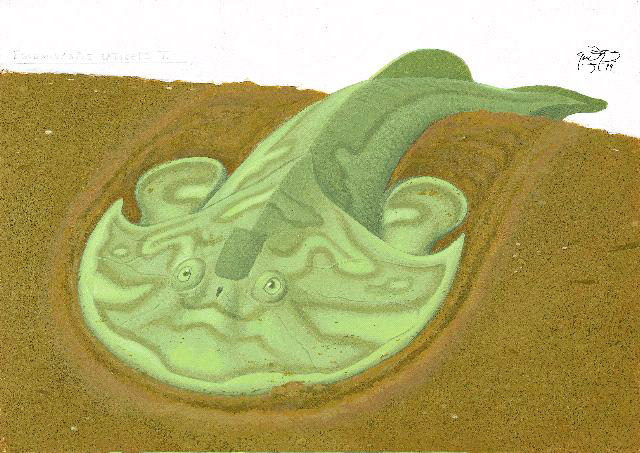Osteostracans
The bottom–dwelling osteostracans were abundant in Euramerica during the Silurian and Devonian periods.
 (68 kb) Their horseshoe-shaped head was quite flat, with two close-set eyes on top and a large circular opening (the oralobranchial opening) on the underside. It is likely that most osteostracans fed by filtering mud and sand along the bottom. Osteostracans were among the rare agnathans to posses paired pectoral appendages, although these structures cannot really be compared to gnathostome fins.
(68 kb) Their horseshoe-shaped head was quite flat, with two close-set eyes on top and a large circular opening (the oralobranchial opening) on the underside. It is likely that most osteostracans fed by filtering mud and sand along the bottom. Osteostracans were among the rare agnathans to posses paired pectoral appendages, although these structures cannot really be compared to gnathostome fins.
The interior of their skull, called the head shield, was made of a dense mass of cartilage covered by a thin bony layer. This endoskeleton feature was quite easily preserved, and paleontologists of the last century consequently had many specimens with which to study the internal head anatomy. The osteostracan brain bears a striking resemblance to that of today’s lampreys. Above the cranium is a continuous layer of small bony platelets, and the shape of the head is commonly like a horseshoe tapering into two tips, or “horns”, that point towards the rear.
Unusual organs are found on the upper surface of the head shield where disjointed small bony platelets form two elongated areas on each side of the head and a third between the eyes. The skull’s interior reveals that these areas were packed with nerves and connected to the optic capsule of the brain. Did these zones act as sensory organs similar to the lateral line in other fish? Or were they organs that could detect movement by generating an electric field, like some fish do today? Nobody knows for certain...
It seems that Miguasha’s osteostracans were the last of their group, as more recent osteostracans have never been found in younger sedimentary rock layers. The unarmoured rear section is even preserved in some Miguasha specimens, which is very rare for osteostracans.

 (68 kb) Their horseshoe-shaped head was quite flat, with two close-set eyes on top and a large circular opening (the oralobranchial opening) on the underside. It is likely that most osteostracans fed by filtering mud and sand along the bottom. Osteostracans were among the rare agnathans to posses paired pectoral appendages, although these structures cannot really be compared to gnathostome fins.
(68 kb) Their horseshoe-shaped head was quite flat, with two close-set eyes on top and a large circular opening (the oralobranchial opening) on the underside. It is likely that most osteostracans fed by filtering mud and sand along the bottom. Osteostracans were among the rare agnathans to posses paired pectoral appendages, although these structures cannot really be compared to gnathostome fins.The interior of their skull, called the head shield, was made of a dense mass of cartilage covered by a thin bony layer. This endoskeleton feature was quite easily preserved, and paleontologists of the last century consequently had many specimens with which to study the internal head anatomy. The osteostracan brain bears a striking resemblance to that of today’s lampreys. Above the cranium is a continuous layer of small bony platelets, and the shape of the head is commonly like a horseshoe tapering into two tips, or “horns”, that point towards the rear.
Unusual organs are found on the upper surface of the head shield where disjointed small bony platelets form two elongated areas on each side of the head and a third between the eyes. The skull’s interior reveals that these areas were packed with nerves and connected to the optic capsule of the brain. Did these zones act as sensory organs similar to the lateral line in other fish? Or were they organs that could detect movement by generating an electric field, like some fish do today? Nobody knows for certain...
It seems that Miguasha’s osteostracans were the last of their group, as more recent osteostracans have never been found in younger sedimentary rock layers. The unarmoured rear section is even preserved in some Miguasha specimens, which is very rare for osteostracans.
Site map | Feedback | Links | Sources | Credits
Osteostracans
<< Euphanerops | Escuminaspis >>



